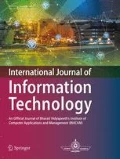Abstract
This paper presents the design of a compact Wang shape MIMO antenna with tri-band operation for LTE 2500, 2.4/5.2 GHz WLAN, 2.5 GHz WiMAX, 8 GHz ITU application. The Wang shape MIMO antenna occupies an overall size of 70 × 52 mm2 that includes the ground plane and substrate. The radiating elements are used to generate three resonant frequencies at 3.1 GHz, 6.2 GHz and 7.7 GHz. The simulated impedances bandwidths (|S11| < − 10 dB) are about 110 MHz (3.1–3.2101 GHz), 90 MHz (6.2–6.3386 GHz) and 280 MHz (7.6–7.9029 GHz) for three operating bands respectively. Here the return loss and mutual coupling of the proposed antenna system are improved over the three resonant frequencies. The simulated result shows reasonably good agreement with the measured results by using R&S ZVA 40 vector network analyzer. The radiator has a low envelope correlation coefficient with values are equal to approximately less than 0.025, which will proves that the wang-shape MIMO radiator shows better diversity performance. The wang-shape MIMO radiator has improves the parameters of reflection coefficient, mutual coupling, realized gain, group delay, real/imaginary impedances and diversity gain.













Similar content being viewed by others
References
Sun XB, Cao MY (2017) Mutual coupling reduction in an antenna array by using two parasitic microstrips. AEU Int J Electron Commun 74:1–4
Nikolic MM, Djordjevic AR, Nehorai A (2005) Microstrip antennas with suppressed radiation in horizontal directions and reduced coupling. IEEE Trans Antennas Propag 53(11):3469–3476
Yang F, Rahmat-Samii Y (2003) Microstrip antennas integrated with electromagnetic band-gap (EBG) structures: a low mutual coupling design for array applications. IEEE Trans Antennas Propag 51(10):2936–2946
Lu YF, Lin YC (2013) Electromagnetic band-gap based corrugated structures for reducing mutual coupling of compact 60 GHz cavity-backed antenna arrays in low temperature co-fired ceramics. IET Microws Antennas Propag 7(9):754–759
OuYang J, Yang F, Wang ZM (2011) Reducing mutual coupling of closely spaced microstrip MIMO antennas for WLAN application. IEEE Antennas Wirel Propag Lett 10:310–313
Salehi M, Tavakoli A (2006) A novel low mutual coupling microstrip antenna array design using defected ground structure. AEU Int J Electron Commun 60(10):718–723
Chae SH, Oh SK, Park SO (2007) Analysis of mutual coupling, correlations, and TARC in WiBro MIMO array antenna. IEEE Antennas Wirel Propag Lett 6:122–125
Wei K, Li J, Wang L, Xing Z, Xu R (2016) S-shaped periodic defected ground structures to reduce microstrip antenna array mutual coupling. Electron Lett 52(15):1288–1290
Blanch S, Romeu J, Corbella I (2003) Exact representation of antenna system diversity performance from input parameter description. Electron Lett 39(9):705–707
Ghosh CK (2016) A compact 4-channel microstrip MIMO antenna with reduced mutual coupling. AEU Int J Electron Commun 70(7):873–879
Shin H, Lee JH (2003) Capacity of multiple-antenna fading channels: spatial fading correlation, double scattering, and keyhole. IEEE Trans Inf Theory 49(10):2636–2647
Shinde PN, Shinde JP (2015) Design of compact pentagonal slot antenna with bandwidth enhancement for multiband wireless applications. AEU Int J Electron Commun 69(10):1489–1494
Gibbins D, Klemm M, Craddock I, Preece A, Leendertz J, Benjamin R (2009) Design of a UWB wide-slot antenna and a hemispherical array for breast imaging. In: 3rd European conference on antennas and propagation, 2009, EuCAP 2009, pp 2967–2970. IEEE, New York
Chen HD (2003) Broadband CPW-fed square slot antennas with a widened tuning stub. IEEE Trans Antennas Propag 51(8):1982–1986
Dastranj A, Imani A, Naser-Moghaddasi M (2008) Printed wide-slot antenna for wideband applications. IEEE Trans Antennas Propag 56(10):3097–3102
Dastranj A, Abiri H (2010) Bandwidth enhancement of printed E-shaped slot antennas fed by CPW and microstrip line. IEEE Trans Antennas Propag 58(4):1402–1407
Chiou JY, Sze JY, Wong KL (2003) A broad-band CPW-fed strip-loaded square slot antenna. IEEE Trans Antennas Propag 51(4):719–721
Jan JY, Su JW (2005) Bandwidth enhancement of a printed wide-slot antenna with a rotated slot. IEEE Trans Antennas Propag 53(6):2111–2114
Sung Y (2012) Bandwidth enhancement of a microstrip line-fed printed wide-slot antenna with a parasitic center patch. IEEE Trans Antennas Propag 60(4):1712–1716
Shinde PN, Mishra BK (2013) Design of triple band slot antenna for 802.11 a/b WLAN and upper UWB application using pentagon tuning stub. Int J Microw Optic Technol 8(1):17-11
Cheng S, Hallbjorner P, Rydberg A (2008) Printed slot planar inverted cone antenna for ultrawideband applications. IEEE Antennas Wirel Propag Lett 7:18–21
Li P, Liang J, Chen X (2006) Study of printed elliptical/circular slot antennas for ultrawideband applications. IEEE Trans Antennas Propag 54(6):1670–1675
Liu J, Cheng Y, Nie Y, Gong R (2013) Metamaterial extends microstrip antenna. Microwaves & RF 52(12):69
Xu HX, Wang GM, Qi MQ (2013) A miniaturized triple-band metamaterial antenna with radiation pattern selectivity and polarization diversity. Progr Electromagnet Res 137:275–292
Xu HX, Wang GM, Lv YY, Qi MQ, Gao X, Ge S (2013) Multifrequency monopole antennas by loading metamaterial transmission lines with dual-shunt branch circuit. Prog Electromagnet Res 137:703–725
Cai T, Wang GM, Zhang XF, Shi JP (2015) Low-profile compact circularly-polarized antenna based on fractal metasurface and fractal resonator. IEEE Antennas Wirel Propag Lett 14:1072–1076
Li Z, Du Z, Takahashi M, Saito K, Ito K (2012) Reducing mutual coupling of MIMO antennas with parasitic elements for mobile terminals. IEEE Trans Antennas Propag 60(2):473–481
Farahbakhsh A, Mosalanejad M, Moradi G, Mohanna S (2014) Using polygonal defect in ground structure to reduce mutual coupling in microstrip array antenna. J Electromagnet Waves Appl 28(2):194–201
Gesbert D, Shafi M, Shiu DS, Smith PJ, Naguib A (2003) From theory to practice: an overview of MIMO space-time coded wireless systems. IEEE J Sel Areas Commun 21(3):281–302
Author information
Authors and Affiliations
Corresponding author
Rights and permissions
About this article
Cite this article
Babu, K.V., Anuradha, B. Design and performance analysis of tri-band Wang shaped MIMO antenna. Int. j. inf. tecnol. 12, 559–566 (2020). https://doi.org/10.1007/s41870-020-00443-7
Received:
Accepted:
Published:
Issue Date:
DOI: https://doi.org/10.1007/s41870-020-00443-7




